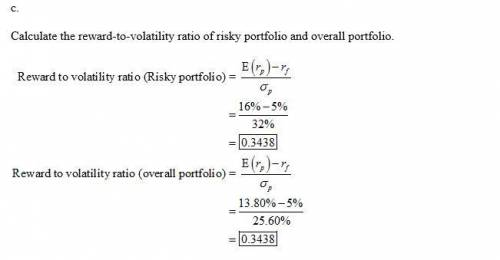
Business, 07.03.2020 04:55 anonymous176
Assume that you manage a risky portfolio with an expected rate of return of 16% and a standard deviation of 32%. The T-bill rate is 5%. Your client chooses to invest 80% of a portfolio in your fund and 20% in a T-bill money market fund.
a. What is the expected return and standard deviation of your client's portfolio? (Round your answers to 2 decimal places.)
Expected return % per year
Standard deviation % per year
b. Suppose your risky portfolio includes the following investments in the given proportions:
Stock A 28%
Stock B 34%
Stock C 38%
What are the investment proportions of your client’s overall portfolio, including the position in T-bills? (Round your answers to 2 decimal places.)
Security Investment
Proportions
T-Bills %
Stock A %
Stock B %
Stock C %
c. What is the reward-to-volatility ratio (S) of your risky portfolio and your client's overall portfolio? (Round your answers to 4 decimal places.)
Reward-to-Volatility Ratio
Risky portfolio
Client’s overall portfolio

Answers: 3


Another question on Business

Business, 21.06.2019 16:30
What are some of the miranda restrictions on questioning someone?
Answers: 1

Business, 21.06.2019 18:20
James sebenius, in his harvard business review article: six habits of merely effective negotiators, identifies six mistakes that negotiators make that keep them from solving the right problem. identify which mistake is being described. striving for a “win-win” agreement results in differences being overlooked that may result in joint gains.
Answers: 2

Business, 21.06.2019 21:00
The market price of cheeseburgers in a college town increased recently, and the students in an economics class are debating the cause of the price increase. some students suggest that the price increased because the price of beef, an important ingredient for making cheeseburgers, has increased. other students attribute the increase in the price of cheeseburgers to a recent increase in college student enrollment.1. the first group of students thinks the increase in the price of cheeseburgers is due to the fact that the price of beef, an important ingredient for making cheeseburgers, has increased. (what happened to demand and supply, shift to the right or left)2. the second group of students attributes the increase in the price of cheeseburgers to the increase in college student enrollment. (what happens to demand and supply, shift to the right or left)3. suppose that both of the events you analyzed above are partly responsible for the increase in the price of cheeseburgers. based on your analysis of the explanations offered by the two groups of students, how would you figure out which of the possible causes was the dominant cause of the increase in the price of cheeseburgers? (choose a, b,c, or d)a)if the price increase was small, then the supply shift in the market for cheeseburgers must have been larger than the demand shift.b)if the equilibrium quantity of cheeseburgers decreases, then the demand shift in the market for cheeseburgers must have been larger than the supply shift.c)if the equilibrium quantity of cheeseburgers decreases, then the supply shift in the market for cheeseburgers must have been larger than the demand shift.d)whichever change occurred first must have been the primary cause of the change in the price of cheeseburgers.
Answers: 2

Business, 22.06.2019 11:20
Aborrower takes out a 30-year adjustable rate mortgage loan for $200,000 with monthly payments. the first two years of the loan have a "teaser" rate of 4%, after that, the rate can reset with a 5% annual payment cap. on the reset date, the composite rate is 6%. what would the year 3 monthly payment be?
Answers: 3
You know the right answer?
Assume that you manage a risky portfolio with an expected rate of return of 16% and a standard devia...
Questions






Spanish, 21.10.2020 20:01



Mathematics, 21.10.2020 20:01


Mathematics, 21.10.2020 20:01

Chemistry, 21.10.2020 20:01


Advanced Placement (AP), 21.10.2020 20:01

English, 21.10.2020 20:01


Mathematics, 21.10.2020 20:01



Mathematics, 21.10.2020 20:01





